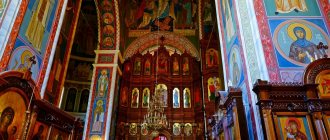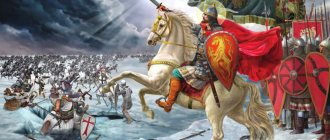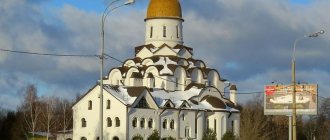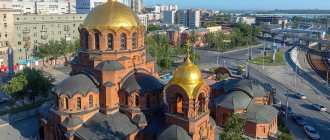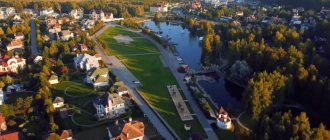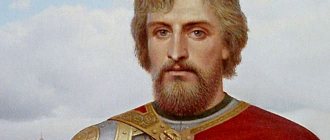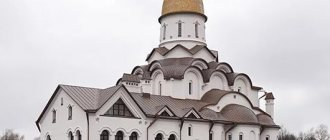Website: https://hramnevskogo.ru Email, Address: St.
Lobachevsky, 23 Telephone Schedule of services: https://hramnevskogo.ru/raspisanie-bogosluzheniy.html Directions:
From the Prospekt Vernadskogo metro station by buses No. 793, 788 From the Yugo-Zapadnaya metro station by buses No. 688, 785 From the Kuntsevskaya metro station by buses No. 688 and 688k
Pskov. Military temple
The temple in the name of St. Alexander Nevsky in Pskov became the first military temple restored in Russia - services began here in 1992. Archpriest Oleg Teor, the rector of the church, spiritually cares for the military personnel of the famous Pskov Airborne Division, and has been with them to hot spots more than once. The temple provides financial assistance to the military and takes care of veterans. There is a museum and a library attached to it.
— The task of a priest is to spiritually strengthen a person when he is serving in the army. In this ministry, we can rely on traditions that existed before 1917,” says Father Oleg. — The life and service of the holy noble prince Alexander Nevsky is a worthy image of service to the fatherland, which can become a guideline today.
In church architecture at that time, two main styles dominated - Russian and Byzantine (more correctly, neo-Byzantine). The Russian style was characterized by the use of onion domes or tents, keel-shaped arches, Old Russian decor, and the use of tiles . For neo-Byzantine - dome forms, “striped” masonry of facades, the use of arches and sparse decoration. The appearance was dominated by the majestic forms of domes, apses and arches. Almost the entire 19th century was marked by the construction of cathedrals in honor of St. Alexander Nevsky. Three emperors bore his name - Alexander I the Blessed, Alexander II the Liberator and Alexander III the Peacemaker.
The most grandiose of the surviving cathedrals is located in the capital of Bulgaria - Sofia. It was designed and built by the construction bureau of A. N. Pomerantsev in 1904–1912. The idea of building a cathedral was voiced in 1879, the laying of a stone at the temple construction site took place in 1882, and the first meeting of the construction commission took place only in 1894. The design of the cathedral reflected the highest artistic and constructive level of the era. The temple has a massive dome on a drum, surrounded on three sides by lateral semicircles of apses. This type of architectural composition is called triconcha
(that is, three
conchs
- three semi-domes of the vault). The central and side naves stretch to the west towards the 51-meter bell tower. Thanks to the gallery surrounding the cathedral, the composition acquired a pyramidal character. The main altar was dedicated to Saint Alexander Nevsky, the southern one to Saint Tsar Boris I of Bulgaria, and the northern one to Saints Cyril and Methodius.
Together with A. N. Pomerantsev, his assistants worked on the project - architect A. N. Smirnov (1869–1928) and architect-artist A. A. Yakovlev (1879–1951). They were also involved in the design of the interior decoration and supervised the painting of the cathedral. Artists from Russia were entrusted to paint the dome and vaults of the temple. In 1912, the painting of the temple was completed, and the consecration of all three thrones took place on September 12, 13 and 14, 1924. The unity of creative leadership ensured its artistic integrity.
If the cathedral in Sofia serves as an example of a temple of the neo-Byzantine style, then the cathedral in Tallinn in the name of St. Alexander Nevsky was built in the Russian style by another magnificent master of church architecture, Mikhail Timofeevich Preobrazhensky (1854–1930). The dedication of the temple to Saint Alexander Nevsky was associated with the miraculous salvation of the imperial family during a train crash in Borki on October 17, 1888. In memory of this event, many churches were built in Russia, among which the Tallinn Cathedral plays perhaps the main role. Its decorative appearance expressively reflects the concept of the “Russian style of Emperor Alexander III,” who preferred the forms of Moscow-Yaroslavl architecture of the 17th century.
The cathedral was built in 1895–1900 and was intended to become the most significant temple of the city, its architectural dominant. It remains so to this day.
For the history of Russian culture, the most important interest is the cathedrals built in the 19th century, but destroyed in the 20th century.
The cathedral in Vyatka (1839–1864) was dedicated to the memory of Emperor Alexander I, who visited the city in 1824. The project was developed by A.L. Vitberg, who is known as the author of the first project of the Cathedral of Christ the Savior on Sparrow Hills in Moscow. But the temple in Vyatka represents an example of the search for a national style. The basis of the composition is a grandiose dome on a drum surrounded by side domes. Despite the appeal to neo-Gothic, there are many details in its architecture that refer us to Moscow architecture of the late 17th century.
The Cathedral in the name of St. Alexander Nevsky in Baku (1888–1898) is a mature work of the “Russian style of Emperor Alexander III,” like the cathedral in Tallinn. But this temple has a tented roof. The cathedral was founded by Emperor Alexander III on October 8, 1888 during his trip to the Caucasus. The laying ceremony was led by the Exarch of Georgia, His Eminence Archbishop Palladius.
The author of the project, architect R. R. Marfeld (1852–1921), demonstrated masterly mastery of the technique of decorative brickwork. The main feature of the composition was the roll call of the tents. The tent on the drum was surrounded by decorative onion domes. The belfry's tent was complemented by the hipped roof of the porch. The cathedral was visible from afar; for many years it remained the tallest in the city. It served as the prototype for the Cathedral of Christ the Savior in Borki, which was later built on the site of the crash of the imperial train.
The stylistic range of the Russian style was so wide that it allowed the use of motifs from various periods in the history of Russian medieval architecture. For the Cathedral of St. Alexander Nevsky in Warsaw (1894–1912), motifs of Vladimir-Suzdal architecture of the 12th – early 13th centuries were chosen. Emperor Alexander III considered that “an Orthodox cathedral in the style of Russian churches of the 12th century, very close to Greco-Romanesque, would be more in harmony with the general style of the outstanding buildings of Warsaw.” The competition, in which the most famous masters participated, was won by Leonty Nikolaevich Benois (1856–1928). The cathedral stood on Saxon Square and was the tallest building in the city. The traditional Russian five-domed structure, the bulbous completion of the domes, and the three-part structure of the facades developed the traditions of Russian church architecture. Particularly exquisite was the ornamental white stone decoration of the walls, the rhythm of the domes and arches, and the mosaic compositions above the entrance to the temple. The painting program belonged to Professor N.V. Pokrovsky. The paintings of the cathedral were carried out by famous masters: V. M. Vasnetsov, N. N. Kharlamov, V. V. Belyaev, M. S. Sudkovsky, A. P. Ryabushkin, F. R. Railyan, N. A. Koshelev, N. P. Shakhovskoy, M. A. Titov and others. The main altar was decorated with the composition “Rejoices in You,” made according to a sketch by V. M. Vasnetsov.
City cathedrals in honor of Alexander Nevsky were also built in the Volga cities of Russia. Two of them were erected according to the designs of the church architect Alexander Alexandrovich Yashchenko (1842–1893). The construction of the cathedral in Rostov-on-Don (1891–1908) was dedicated to the deliverance of Emperor Alexander II from the hand of an assassin on April 4, 1866. The ceremonial laying took place on the New Bazaar Square in 1891. The architect turned to the traditional five-domed structure. The area of the building exceeded 500 square meters, and it surpassed all buildings in the city in height. The walls and vaults were decorated with paintings. All three iconostases and the floor were covered with marble.
In 1901–1918, according to his own design, the Cathedral of St. Alexander Nevsky was built in Tsaritsyn. There is also a triconch
was supplemented with decorative side domes, creating the characteristic appearance of a five-domed temple. It rose above the low buildings, forming a memorable silhouette of the city.
The most grandiose of the churches built in honor of St. Alexander Nevsky was the 21-domed Cathedral in Memory of the Liberation of Peasants on Miusskaya Square in Moscow (1913–1917). The project was created by A. N. Pomerantsev back in 1899. The cathedral was designed for 5,000 worshipers. The large capacity of the temple was achieved through the use of intersecting reinforced concrete arches (a technique widely used in temple construction in the 1890s). Thanks to the multi-domed wedding, it resembled Moscow churches of the late 15th – 16th centuries. The groundbreaking took place on September 22, 1913, construction was almost completed by 1917, but the cathedral was dismantled in the late 1950s.
The column is based on the works of V. G. Lisovsky, A. V. Materikin, Yu. R. Savelyev, M. T. Preobrazhensky, K. A. Tizik.
Saint Petersburg. Holy Prince Alexander Nevsky - the heavenly patron of the city
The Holy Trinity Alexander Nevsky Lavra was founded in 1713 by Peter I; the relics of the holy noble prince Alexander Nevsky, who became the patron saint of the Northern capital, rest here. It is believed that Peter I was more attracted to the image of a ruler and warrior than a monk. However, the governor of the Alexander Nevsky Lavra, Archimandrite Nazariy (Lavrinenko), believes that it was the spiritual component that played an important role in the choice of the emperor.
“Alexander Nevsky put the threat of spiritual enslavement above the economic threat and therefore waged wars in the West, and subtle diplomacy in the East,” said Archimandrite Nazariy. “And Peter I, understanding the noble prince and, probably, thinking the same way as him, chose Saint Alexander Nevsky as the patron of the new capital. This decision of his, like the founding of one of the largest monasteries on the Neva in the name of the holy noble prince, can serve as an example of the right spiritual choice.
Shrines and relics of the temple
After the closure and looting of the temple by the Bolsheviks, many shrines stored here were lost. Since the cathedral was returned to the church and began to be restored, many revered icons and pieces of holy relics have arrived here. Pilgrims can venerate the relics:
- fourteen Russian saints;
- ten elders from Optina Hermitage;
- Vmch. Panteleimon;
- St. Euthymius of Suzdal;
- St. John of Damascus;
- St. Macarius of Zheltovodsky;
- right Alexy Bortsurmansky;
- St. Seraphim of Sarov.
In addition to arks, holy relics can be placed in special reliquaries on images of saints. For example, the church contains icons of Solovetsky and Nizhny Novgorod saints with parts of their relics. The image of the prince is especially revered. Alexander Nevsky with a particle of his relics.
All-Merciful Savior
Belt of the Blessed Virgin Mary
Cancer with the relics of St. right warrior Feodor Ushakov
Novosibirsk Frontline of struggle, frontline of mercy
Alexander Nevsky Cathedral was built in 1899. Today it has become a missionary outpost of the largest metropolis in Siberia.
“Every year, our missionary group on the ship “St. We are constantly expanding our geography: this year we visited Kazakhstan. There is an anti-sectarian center at our temple. And if Saint Alexander Nevsky defended his fatherland and faith with a sword in his hands, then we protect our fellow citizens from false teachings and sects with the help of educational activities and preaching. Also at the temple there are the squad of St. Alexander Nevsky, Orthodox children's and youth camps, and our Orthodox brotherhood and sisterhood help the poor and support large families...
History of the Alexander Nevsky Cathedral
At the end of the 18th century, Saratov developed at a rapid pace, production grew, and, consequently, the population. Urban development went far beyond the city ramparts and reached modern Radishcheva and Sobornaya streets. Here, on an empty outlying site, during the formation of the Saratov province, estates of the governor, vice-governor and public places for provincial institutions were built.
In 1803, the city government adopted a new plan for Saratov, which provided for the creation of a square - the administrative center of the city - next to public places. The area was done. At first it was called Shameful (from the word shame - “a spectacle that appears to the eye”), and soon received a name - Public Places Square. According to the same plan, a new cathedral was to be built on this square.
In January 1808, the plague began in Saratov, quarantine was declared and cordons were set up. Senator O.P. came to Saratov from St. Petersburg to fight the plague. Kozodavlev with a whole retinue of secretaries. Many in the city said that there was no plague epidemic, as Panchulidzev announced, but there were only isolated cases. Despite this, Kozodavlev diligently went to church for services and spent time with Panchulidzev at lunches, dinners and dances. On April 20 of the same year, the quarantine was lifted and free entry and exit from the city was allowed. For the successful “fight” against the monstrous plague at the request of O.P. Kozodavlev, Panchulidzev, became the governor of Saratov, and a little later Kozodavlev himself was awarded the Order of Alexander Nevsky. In memory of the deliverance of Saratov from the deadly plague, they decided to erect a temple on the Public Places Square. This was the first prerequisite for the creation of the cathedral on the new square.
The temple project was entrusted to the famous architect V.I. Suranov. In the drawing he presented, the five-domed cathedral church with columned porticos looked ordinary, differing little from churches of a similar type - the project was not approved.
Meanwhile, it was already 1812, and the wars with Napoleon began. Saratov warriors also took part in the hostilities as part of the militia forces. After the war, Saratov residents wanted the temple to be dedicated to the memory of the militia heroes who died on the battlefields. This is already the second prerequisite for the creation of the cathedral.
At the same time, they decided to make the new cathedral a cathedral, where the bishop would perform divine services. Tsar Alexander I commissioned the famous Russian architect Vasily Petrovich Stasov to design such a temple, who, when planning, proceeded from the traditions of ancient Russian architecture. According to the design, the cathedral building resembled a cube decorated on all sides, covered with a low Roman dome. The project was accepted immediately, and already on August 30, 1815, the foundation stone for the new cathedral took place.
Maybe because of incorrect calculations, maybe because of something else, but in the spring of 1822 the stone dome collapsed, bringing down the upper part of the walls. This accident somewhat delayed the construction of the cathedral. It was ready and consecrated on March 28, 1826.
Construction of the bell tower took only two years, from 1840 to 1842. Grigory Vasilyevich Petrov was appointed the chief architect of this project.
Now it is worth noting the blatant cases of theft and corruption that flourish among the elite of Saratov, which, by the way, led the construction of the cathedral. The chairman of the temple construction commission was Governor A.D. himself. Panchulidzev. Other members of the commission spoke extremely unpleasantly about him:
“... Alexey Davydovich could not let anything pass him by - be it someone else’s wife or someone else’s money, and there’s no need to talk about someone else’s fame.”
Thus, during the construction of the cathedral, the governor did not miss the money that should have been used for the construction of the cathedral: 25 thousand rubles of barracks capital, 47 thousand - the remains of the amount collected for the formation of the Jaeger regiment during the war, 9 thousand - the remains of arrears collected by the nobility . Over time, the echo of our governor’s abuses reached St. Petersburg. In 1826, Senator N.I. came to Saratov for an inspection. Ogarev. The results of his audit are simply amazing: Panchulidzev was counted as 30 thousand rubles in debt, which he never paid, having died.
There is such a legend that when Senator Ogarev asked: “Under Governor Belyakov, the Saratov province at least prayed to God, but under you what did it do for 20 years?” Panchulidzev answered this: “Danced, Your Excellency, danced.”
Nevertheless, the construction of the Alexander Nevsky Cathedral ended. Saratov residents paid 311,583 rubles 60 kopecks for it. The bell tower of the cathedral was built with funds from the then famous philanthropist Maria Feodorovna Dmitrieva, who gave 21 thousand rubles from her own pocket. In addition, she donated a bell weighing 550 pounds (8.8 tons) and rich vestments with precious stones for local icons. M.f. By resolution of the Synod, Dmitrieva was numbered among the parishioners of the cathedral and designated as its trustee, and soon an entire Saratov street would be named in her honor.
Immediately after the opening of the Alexander Nevsky Cathedral, the square around it was renamed Novosobornaya (since Cathedral Square was already in Saratov). In Soviet times, it was called Kommunarnaya, in honor of the Paris Commune, then it was named after Chernyshevsky, after the collapse of the union, the square was renamed Cathedral. Now it is again the square named after N.G. Chernyshevsky.
A little more than a century later, in the wake of the denial of the tsarist system and the revision of history, the War of 1812 was not recognized as the Patriotic War; on the part of Russia, it was seen only as a reaction to the “progressive liberation policy of Napoleon.” This was one of the main reasons why the Saratov Cathedral, like many other monuments of 1812, was destined to be included in an extensive plan to combat the memory of 1812.
At first, however, a very large bell was installed on the bell tower of the cathedral in 1918, which undoubtedly inspired great hopes for the continuation of the worthy life of the temple, but soon church services in it were stopped. For some time, two Saratov theaters worked there - the Peasant Theater and the Young Spectator Theatre. In 1930, the Cathedral was transferred to the Agricultural Institute, then to the workers' club, then to Sarpromcreditsoyuz. In 1934, they planned to build a summer indoor theater in its place. At the end of the 30s of the last century, the cathedral building was completely destroyed, and in its place, according to the NKVD, the Dynamo stadium was built.
Gorodets. Monk, patron of students
In this city, the prince took monastic vows with the name Alexy. Here, in the monastery in the name of the Feodorovskaya Icon of the Mother of God, he died.
“Two Orthodox gymnasiums are named here in honor of St. Alexander Nevsky,” says priest Alexey Parfenov, dean of the Gorodetsky and Borovsky districts. “I wouldn’t treat this solely as a tribute to memory.” After all, we must not only give the child a sum of scientific knowledge and a culture of thinking, but also form in him the correct attitude towards this knowledge, instill in him a desire for truth, for correct, moral actions. Saint Alexander Nevsky is an example of how one can serve the faith and the fatherland, how to use all one’s talents, knowledge and skills for good.
central part
Fragment of the central part.
View of the central part on the left.
Fragment of the central part.
Iconostasis.
Center, view from the Iconostasis.
Icon of the Donskaya Most Holy Theotokos.
Moscow. An example for diplomats
In honor of the blessed Prince Alexander, it is planned to consecrate the temple under construction at MGIMO (U) of the Russian Foreign Ministry.
“The blessed Prince Alexander is known as one of the outstanding diplomats of the Russian Middle Ages,” says the rector of the temple under construction, priest Igor Fomin. “He became an example of not only courageous and sincere service to his homeland; Saint Alexander is also an example of a person whose actions were always consistent with his faith and with the moral guidelines that Christianity gives to a person. This example is especially important for the future diplomat, who in his future work may more than once have to face difficult problems, including in the area of moral choice.
On the screensaver there is a fragment of a photo: Wikipedia
Narthex
Doors in the Narthex.
Painting of the dome of the Narthex.
Lord Almighty.
Intercession of the Blessed Virgin Mary.
From left to right: Oleg Bryansky, Andrei Bogolyubsky, Prince Boris.
From left to right: Prince Gleb, Fyodor of Novgorod, Vasily of Rostov.
Prince Vasily of Rostov.
Founder of Nizhny Novgorod: Prince Georgy Vsevolodovich.
South Arch
View of the Iconostasis of the South Arch.
Presentation of the Blessed Virgin Mary into the temple.
Epiphany.
Transfiguration.
Nativity.
